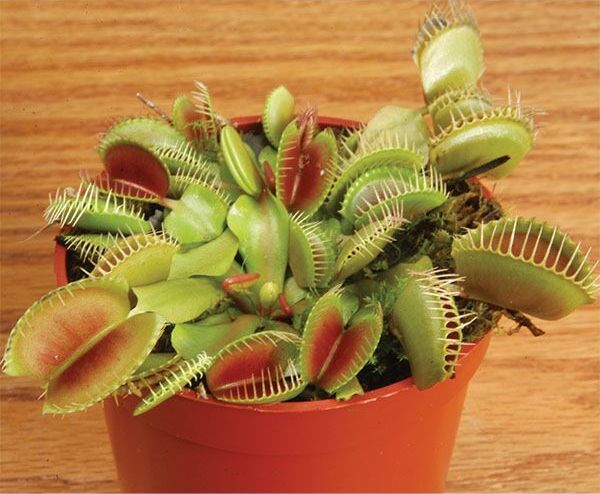What are Carnivorous Plants?
Welcome to the captivating world of Carnivorous Plants, where plants come alive with a voracious appetite. From the iconic Venus Flytrap, whose snapping jaws have fascinated generations, to the delicate and alluring Sundew, with its sparkling dew-drop tentacles, our collection of fascinating carnivorous plants is anything but ordinary!
Carnivorous plants are fascinating and unique botanical wonders. These remarkable plants have evolved to thrive in nutrient-poor environments by capturing and digesting insects and other small organisms. With specialized adaptations like sticky surfaces, trap-like structures, or pitcher-shaped leaves, they lure and trap their prey. This carnivorous lifestyle allows them to supplement their diet with essential nutrients typically lacking in their habitat. Their intriguing nature and ability to thrive in challenging conditions make them intriguing additions to any plant collection.
Carnivorous Plant Care
The care and culture of carnivorous plants are easy with a few simple instructions.
Sun Requirement
Full sun requirements, If the Venus fly trap stretches, it simply means it is looking for more light. To grow it tight in the pot, be sure give plenty of light.
Water
Use distilled water for the carnivorous plants. the spoon leaf sun dew and Venus fly trap like to be kept in a saucer of distilled water. The Sarracenias (purple pitcher plant) do well in moist sphagnum moss, and the nepenthes or pitcher plants should have some distilled water in their pitchers. This usually happens naturally but at times you may have to fill the bottom of the pitchers with water.
Browning of Pitchers or Pads
When a Venus fly trap pad turns brown or black, it usually means that it has eaten and absorbed its prey and then dies. The same goes with the pitchers, once they have done their job or they just get old, they will brown. Simply, selectively remove old pads or pitchers to bring your plant back to its pristine show.
4 Popular Carnivorous Plants
Venus Flytrap: Nature’s Ultimate Bug-Eater
The Venus Flytrap is one of the most iconic carnivorous plants. Unlike most plants that rely on sunlight and soil for sustenance, this clever predator lures bugs with its striking reddish lobes. When triggered, the lobes snap shut in milliseconds, capturing prey for digestion. It's a mesmerizing process to witness, making the Venus Flytrap a must-have for plant enthusiasts. For best results, place it in a sunny spot with a saucer of water. Even without insects, simply touching the inner lobes will activate the trap—demonstrating how perfectly it’s designed for its role as a bug-eater.

Tropical Pitcher Plant ‘Alata’: The Bold Bug Hunter
If you think the Venus Flytrap is impressive, wait until you meet the Tropical Pitcher Plant ‘Alata.’ This plant's large, vibrant red pitchers grow from the tips of its leaves, attracting insects with their enticing appearance. Once an insect slips into the pitcher, it’s trapped by the slippery walls and digestive secretions inside. To care for this unique plant, ensure the pitchers always have fluid at the bottom, and if you’ve recently moved it, top them off with distilled water. This plant thrives in partial sun, with good humidity and air ventilation, making it an ideal choice for bright indoor spaces.

Spoon Leaf Sundew: A Tiny but Mighty Carnivore
The Spoon Leaf Sundew is a small but highly effective insect hunter. Native to the bogs of Asia, its tiny rosettes of leaves are covered in sticky droplets that trap insects when they land. This easy-to-care-for plant requires minimal attention—just keep it in a saucer of water to mimic its natural bog habitat. With its delicate, dewdrop-covered leaves, the Spoon Leaf Sundew adds a unique, low-maintenance touch to any sunny spot in your home.

Purple Pitcher Plant: An Elegant Carnivorous Beauty
Another stunning carnivorous plant to consider is the Purple Pitcher Plant (Sarracenia). Growing 6-8 inches tall, its green pitchers transform into rich burgundy hues, with veins that make them even more striking. The pitcher’s opening is lined with downward-pointing hairs that lure insects inside, where they’re trapped and digested. In spring, a beautiful flower blooms at the center, adding extra charm to this already captivating plant. Keep it in a saucer of water to replicate its boggy habitat, and watch it thrive in moist, humid conditions.

Carnivorous Plant Summary: A Unique Addition to Your Collection
Carnivorous plants like the Venus Flytrap, Tropical Pitcher Plant ‘Alata,’ Spoon Leaf Sundew, and Purple Pitcher Plant are not only beautiful but also showcase nature's ingenious ways of adapting to nutrient-poor environments. Whether you're drawn to the snap of the Venus Flytrap or the elegance of the Purple Pitcher, these unique plants will add a touch of mystery and wonder to your home or garden. Ready to welcome a new predator into your plant collection?

